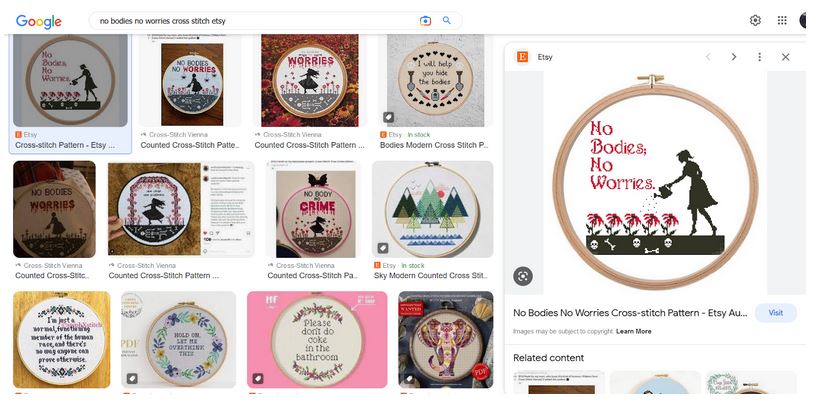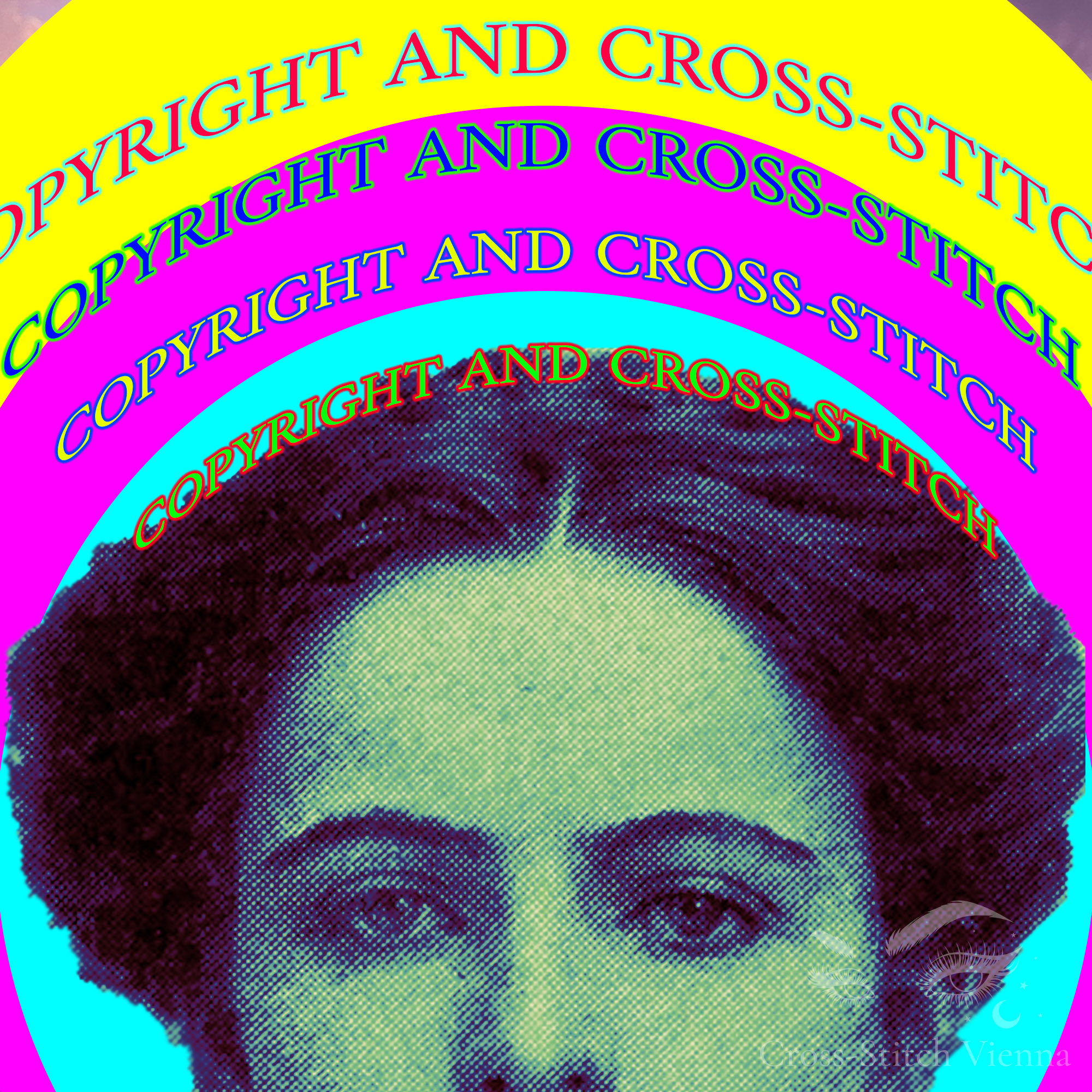Prefer a summary? Visit my Terms and Conditions page.
I recently had a semi-unpleasant situation. I monitor mentions of keywords that have to do with my patterns. I also do deep searches of my patterns or images or anything that could give me a hint that someone created a cross-stitch based on my creations. Just for fun and because the culture of crediting is weaker year by year and I like to know what you are up to, munchkins.
But last Friday, the 17th of February 2023 to be exact, I came across my pattern being sold on Etsy. When I say mine I mean it was a pattern that combined elements from two of my popular free cross-stitch charts – No Body No Crime and No Bodies No Worries. Essentially, it was a pattern merge.
I got annoyed. First of all, the patterns are my creations and I decided to share them for free so nobody should be making money. And if someone one day decides to make money from these patterns, it will be me.
But another thing annoyed me even more – I understood the way the person (I later found out there was a “designer” that sold the pattern to the store) thought. They thought that because they combined elements of two distinct patterns that are labelled as free and came up with a new arrangement, that alone gave them enough right to do whatever they wanted with the pattern.
And lastly, that person did not understand how copyright works.
Cross-Stitch Patterns and Copyright in Austria
The definition tells it all:
A copyright is a type of intellectual property that gives its owner the exclusive right to copy, distribute, adapt, display, and perform a creative work, usually for a limited time.The creative work may be in a literary, artistic, educational, or musical form. Copyright is intended to protect the original expression of an idea in the form of a creative work, but not the idea itself.
Wikipedia
In addition, I am based in Austria, which has a specific longevity term for copyright: the day of creation through the end of the author’s lifetime + 70 years from the death of the author (post mortem auctoris, pma). Source and info about copyright length per country: Wikipedia.
Free does not mean public domain
All over my website, you will see the word “free”. Let’s get it out of the way: free does not mean “free to do whatever you want with”. In this context, free means available for personal use and I have always asserted ownership of the work by adding copyright information in the footer of my website, as well as in the patterns themselves.
A lot of people think that images found on Google are free for grabs. OR images from Pinterest. There is a huuuge issue with people assuming something published on the internet is meant to be available for whatever we, the consumers of the internet, want to do with it.
But unless something is explicitly offered as public domain, a safe assumption to make is that the item we are looking at – digital or not – is protected by copyright.
According to Wikipedia, public domain (PD) refers to “creative work to which no exclusive intellectual property rights apply. Those rights may have expired, been forfeited, expressly waived, or may be inapplicable. Because no one holds the exclusive rights, anyone can legally use or reference those works without permission.” (Source: Wikipedia)
I do not have plans to ever make my work public domain.
There are many resources that are public domain and can be used for cross-stitch patterns. I use a lot of public domain assets to get inspiration for my patterns. I LOVE public domain goodies.
Now, you will ask, if some of my work is inspired by public domain resources, doesn’t it make my patterns public domain too? No. Because:
Copyright protects only the expression of ideas, not the ideas themselves
First of all, I am still taking a copyright-less asset and editing it, adding my secret sauce to the mix. Creating a cross-stitch pattern from an image takes time and patience, and you will never completely copy the image.
I do not simply duplicate public domain assets because that is impossible – I use them as inspiration and add my own creative interpretation of the topic. That makes such patterns uniquely my work.
If you are into a certain style of cross-stitch, chances are we consume pretty much the same stuff. Same music, and the same memes. We will stumble on the same Reddit threads, and obsess over the same new Netflix TV show. And sometimes, people come up with ideas that are eerily similar or on similar topics. It’s normal.
I know for a fact that designers who lean towards dark and morbid use the same sources. And I even see some big gothic cross-stitchers releasing cross-stitch patterns that are the cross-stitch copies of the same digitalised woodcuts that I have saved in my public domain resources library. But they have worked to transform these images into patterns and it ain’t easy. That effort they put into their cross-stitch charts and the choice of thread, size, and so on, makes them the owners of the patterns. BUT not the idea.
You cannot copyright an idea. For example, everyone that has taken the concept of a dark moth and created a cross-stitch pattern in their unique style has not broken any law.

But there is a big difference between a cross-stitch pattern that is “similar” and a blatant and exact copy of elements, structure, and style. We have the concept of “derivative” in copyright. Wikipedia explains, that “a derivative work is an expressive creation that includes major copyrightable elements of an original, previously created first work (the underlying work).
The derivative work becomes a second, separate work independent in form from the first. The transformation, modification or adaptation of the work must be substantial and bear its author’s personality sufficiently to be original and thus protected by copyright.” (Source: Wikipedia). If you do not apply an ounce of originality (like the “designer” behind the “No Body No Crime” pattern cocktail) and just copy, you are breaking the law.
I will give you an example of a derivative. I was browsing Google Image Search (again, googling my patterns because this activity obviously bears ripe fruits) and saw this:

You can already see that the person took my idea and ran with it. But they designed the pattern in their style. Is it illegal? No. But it is not exactly the right thing to do.
Enter plagiarism.
Plagiarism in Cross-Stich Designer Community

It’s a bit of a grey area because plagiarism is not illegal – but it definitely is unethical. At some point, I was made aware of a cross-stitch community drama – someone was stealing ideas from a well-known fibre artist. It’s become a regular thing. It was not illegal but a lot of people, myself included, thought that it was not decent human behaviour.
Cross-stitch pattern creator to cross-stitch pattern creator, I think we have to ready ourselves to have these conversations and be honest about what we get inspiration from. I personally do not think it’s a crime that someone wants to emulate a style of a designer that they like.
But not when livelihood is concerned. If you copy ideas and recreate them in your style with the goal of selling that work, you are being a bit of a knobhead. And definitely 100% knobheady, when you pretend it’s you, who came up with the idea.
(I want to interject here that I did not contact the person who plagiarised my “No Bodies No Worries” pattern. The pattern was sold on Etsy at some point but when I found the image, the listing has been closed. But even if it hadn’t, I wouldn’t have reached out because people will steal ideas and there is little I can do about it. Unless they copy my patterns as they are and sell them, which is a copyright breach. See the beginning of this post).
If you plagiarise someone, you are just stealing someone’s craft. That person’s craft is the result of their work, education in the area, often years of experience, and imagination. It’s extremely shady, especially if the artist themself is trying to make a living from their passion and relies on people buying from them. Let’s be honest, digital cross-stitch patterns are not breaking the bank.
If you choose to take without paying, just like with kinks, keep it in the bedroom. But if you are reading this and nodding, chances are you feel strongly about people claiming credit for work they did not do. And I hope you will try even harder to support creators with the bare minimum method.
What’s the bare minimum method of supporting cross-stitch pattern designers?
Here it is:
Regardless of how you obtain a pattern, the least you can do is credit the author. There is always a way to show appreciation, not necessarily with a public social media post. Do a shoutout in your Whatsapp group or reshare the link to the person’s store on your channels without commenting on how or why. It really helps.
To help you out with understanding how to use the Cross-Stitch Vienna patterns, I updated the Terms & Conditions page. Take a look if you are interested!
As always, may your thread be smooth.
CSV
PS. For those interested in how the pattern thief thing ended. I reported them to Etsy and messaged those, who purchased the pattern (their public info was underneath the pattern listing) before contacting the seller. We had an exchange where they tried to tell me the pattern they “bought from a designer” was different to mine. A very lazy excuse, may I just say once again. The seller hid the listing when I provided more evidence. Then Etsy simply removed the pattern from their platform because they confirmed my claim was justified. The End. I released my version of the stolen pattern: here it is. And also, the whole situation gave me an idea. Stay tuned 😉
Resources you might like:
- Reverse image search if you want to check on your patterns sometimes: https://tineye.com/
- Thread-Bare answers a lot of questions you might have about copyright in this article:https://www.thread-bare.com/blog/cross-stitching-legalities-copyright-artwork-licensing-and-copying
- Peacock & Fig wrote an awesome post about what it means to cross-stitch designers when their work is stolen. One point she made is that those copying and stealing pay less attention to the quality of the chart. https://peacockandfig.com/2017/08/whats-the-big-deal-about-copyright/
- https://www.copyright.com/education-copyright-foundations/


